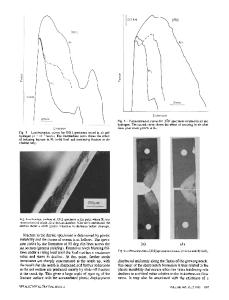The kinetics and micromechanics of hydrogen assisted cracking in Fe-3 pct Si single crystals
- PDF / 2,899,631 Bytes
- 12 Pages / 597.6 x 774 pts Page_size
- 25 Downloads / 300 Views
I.
INTRODUCTION
HYDROGEN-assisted cracking (HAC) in numerous material systems has been extensively studied. However, except for those systems where hydrides are involved, the micromechanical details of crack advance remain today an unresolved issue. This is mainly due to the fact that hydrogen is elusive and that many hydrogen-embrittled materials of interest pbssess very complex microstructures. The resulting behavior of materials under hydrogen-containing environments has led to different opinions on the nature of HAC, ranging from enhanced decohesion['J to enhanced plasticity. [2J From the kinetic point of view, the HAC process involves many factors such as any hydrogen/surface reaction, hydrogen diffusion and collection, and the degradation process at the process zone. These are influenced by temperature, stress state, and microstructure. How to describe correctly this complicated kinetic behavior depends not only on the macroscopic measurements of kinetic data but also on the understanding of the underlying micromechanics. The latter is more easily accomplished on simpler material systems such as single crystals. It is the purpose of this study to elucidate the kinetic and micromechanical behavior of a semi-brittle iron-based single-crystal system. As such, it is appropriate here to outline briefly the existing studies on both polycrystalline materials and single crystals. X. CHEN, fonnerly Graduate Student, University of Minnesota, is Engineer, Singapore Institute of Standards and Industrial Research, Singapore 0511. W. W. GERBERICH, Professor, is with the Deparhnent of Chemica) Engineering and MateriaJ~ Science. University
of Minnesota, Minneap\llis, MN 55455. Manuscript submitted November 9, 1989. METALLURGICAL TRANSACTIONS A
The commonly observed kinetic behavior of HAC in structural materials is schematically described in Figure 1.[3,4J Here, three stages in crack growth rate are often associated with the applied stress intensity factor (Figure lea)). The growth rate in the plateau region of stage II is relatively independent of applied stress intensity but sensitive to test temperature (Figure l(b)). Models applied to this behavior are numerous,[3.5-15J with controversy in the interpretation of how the sequence of events at or near the crack tip leads to subcritical slow crack growth. As a brief overview, several kinetic models based on either reaction rate theory or mechanics are listed in Table I. A more detailed review has been provided by Van Leeuwen.[16J Among the many models, a transient model based on kinetics, trapping, and fracture mechanics has been recently proposed by Gerberich et al.[1l,12J and applied to high-strength 4130, 4340, and maraging steels for the external hydrogen case and to high-strength 4340 steel for the internal hydrogen case. Since the microstructures of these materials are complex, there was unavoidable ambiguity in the justification of the fitting parameters and in the interpretation of the underlying micromechanics. To achieve a better understanding of the kinetic proc
Data Loading...











